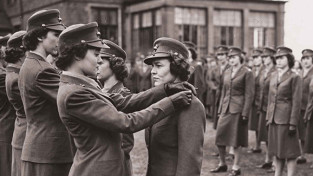Student life during the Civil War
Once the Civil War began, both students and faculty worked to support the Union troops. As later generations would do for American troops during World Wars I and II, Mount Holyoke students knitted socks, sewed haversacks and rolled bandages for Union troops as part of the war effort.
In an essay written for the 1908 Mount Holyoke Alumnae of Hampshire County meeting, Anna C. Edwards, class of 1859 — a classmate of Nancy Hill — recalled the war effort during her first year teaching at Mount Holyoke. “We worked for the soldiers with tireless zeal, sending barrels of socks, mittens and all manner of comforts to the Army front. I have seen our whole family of three hundred knitting socks at the general exercise in seminary hall. Some did not understand the art very well, and each section was under the supervision of a teacher.”
The students were joined in this work by other women living in South Hadley. Priscilla Shaw Bayley, class of 1866, recorded in her diary that students held “recess meeting[s] to pray for our country,” and on Thursday, April 2, 1863, students fasted “for our country,” skipping at least one meal. During these meetings, held in parlors of the Seminary Building, teachers would lead students in prayer for specific family members fighting far away, according to requests filled out earlier and dropped in a box. Faculty members also held community meetings where they read newspaper articles and letters aloud to share information about the war. Edwards saw many announcements for these meetings throughout her time on campus, such as “Miss Chapin read [Major General George B.] McClellan’s address to the army of the Potomac, which has at last moved.” Despite the pervasive atmosphere of trepidation across campus, gatherings like these instilled a sense of order and community.
Students received news of the war and individual soldiers through newspapers and letters from soldiers on the front. One of the first deaths to affect the Mount Holyoke community was that of a student’s brother, who was a soldier in the 10th Massachusetts regiment. An October 6, 1912, newspaper article written by Ellen Parsons, class of 1863, recounted “tense days of student life.” Parsons described a scene in the reading room after the list of those slain in the Battle of Antietam was published. One of her classmates read that her cousin, a colonel, was killed. As soon as she put down the paper and left her seat, another student in her class took it up to learn that her youngest brother had also been killed in the battle. The class of 1863 was much smaller than average, but even so “the only 37 members counted among themselves 10 brothers, one father, one husband and one betrothed, in the Army, to say nothing of first cousins.” According to Edwards’ essay, “From this time [1861] till peace was declared, startling telegrams from the seat of the war became a feature of our student life.”
While the students and faculty coped with heavy personal and political losses, Edwards wrote that “it fell to us students of 1861–1865 to watch with our country through its long night of sorrow and suspense, and to take our diplomas while cannon was booming.”
—By Emily Krakow ’20
December 12, 2018










Leave a Reply